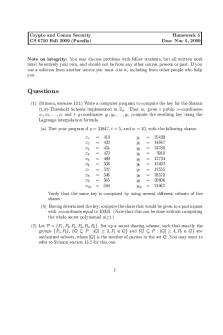Seminar assignments - Homework 3 PDF

| Title | Seminar assignments - Homework 3 |
|---|---|
| Course | Physics Of Semiconductors And Nanostructures |
| Institution | Cornell University |
| Pages | 4 |
| File Size | 318 KB |
| File Type | |
| Total Downloads | 30 |
| Total Views | 187 |
Summary
Homework 3...
Description
Departments of ECE and MSE, Cornell University ECE 4070/MSE 5470: Physics of Semiconductor and Nanostructures Spring 2015 Homework 3
Due on Feb. 20, 2015 at 5:00 PM
Suggested Readings: a) Lecture notes b) Chapter 2 in Kittel (Introduction to Solid State Physics)
Problem 3.1 (A hexagonal lattice in 2D) Consider the following 2D hexagonal lattice:
! ! a) Find the primitive lattice vectors: a1 and a 2 . b) Find the area of the Wigner-Seitz primitive cell. c) Sketch, either on the homework copy or if you can draw a better diagram, the Wigner-Seitz primitive cell. Hint: it should have 6 facets.
! ! d) Find the reciprocal lattice vectors: b1 and b2 . e) Find the area of the first Brillouin zone in k-space. f) Plot carefully the reciprocal lattice points and the first Brillouin zone in k-space in a neat and clean diagram. Identify the reciprocal lattice type from among the 5 possible Bravais lattice types in 2D. It is
1
important that your diagram is neat and accurately scaled otherwise your answer in part (g) will not come out right. g) Draw enough Bragg lines on the reciprocal lattice plot of part (f) to correctly identify the first and the second Brillouin zones. On the same diagram, label all regions that belong to the first BZ and label all regions that belong to the second BZ.
Problem 3.2 (FCC and BCC lattices in 3D) a) Show that the reciprocal lattice of the FCC lattice is the BCC lattice. Hint: Find the primitive vectors for the reciprocal lattice. b) Show that the reciprocal lattice of the BCC lattice is the FCC lattice. Hint: Find the primitive vectors for the reciprocal lattice c) Suppose that the lattice constant (i.e. unit cell size) of Silicon is: a = 5.43095 Angstroms. What is the density of Silicon in kg/m3?
Problem 3.3 (A 2D lattice with a basis) Consider the following 2D lattice made of 2 different kinds of atoms (red-unfilled and black-filled), as shown:
! ! a) Find the primitive lattice vectors, a1 and a 2 , and all the basis vectors and draw them on the figure above (and submit this figure with your homework). How many basis atoms are there per lattice point? b) Find the area of the Wigner-Seitz primitive cell of the direct lattice. c) Sketch, on the figure above, the Wigner-Seitz primitive cell and submit it with your homework. How many atoms are there in one primitive cell?
! ! d) Find the reciprocal lattice vectors: b1 and b2 . e) Find the area of the first Brillouin zone in k-space.
2
f) Sketch the reciprocal lattice points and the first Brillouin zone in k-space in a neat and clean diagram. Also draw the reciprocal lattice primitive vectors. Identify the reciprocal lattice type from among the 5 possible lattice types in 2D.
Problem 3.4 (2D Free electrons in a magnetic field – Sommerfeld model) Consider a 2D free electron gas confined to the x-y plane. In the Sommerfeld model, the energy of an ! electron with wavevector k is, " " " ! 2 k ⋅ k ! 2k 2 = Ek = 2m 2m The velocity is, ! ! ! 1 ! ! "k v k = ∇k E k = " m ! Now suppose a DC magnetic field is switched on and is in the z-direction,B = B o zˆ , as shown below.
()
()
()
z
2D gas
x
y
In the presence of the magnetic field, the momentum of the electron satisfies the equation (assuming no electric field and no scattering), ! !! ! d "k = −e v k × B dt a) In the k-space, if the starting position of the electron (before the magnetic field was switched on) is as shown below, then find the trajectory of the electron in k-space after the magnetic field has been switched on and plot it on the figure below (and hand in the figure with your solutions).
()
b) Continuation of part (a): If in addition, the starting position of the electron (before the magnetic field was switched on) in real space is as shown below, then find the trajectory of the electron in real-space after the magnetic field has been switched on and plot it on the figure below (and hand in the figure with your solutions).
3
y
Starting position xo
x
c) If you did parts (a) and (b) correctly, you would have found that the motion of electron in both k-space and real space is periodic. Find the time period for the motion (i.e. the time taken by the electron to complete one period). d) Staring from ! the equation, ! ! ! d "k (t ) = −e v k × B dt Prove that the energy of the electron is conserved (i.e. does not change) during its motion. Hint: proof is just 1-2 lines of math.
()
e) Before the magnetic field was switched the total current carrier by the electron gas (summing up contributions from all electrons) was given by, ! ! ! ! ! d 2k f k v k =0 J = −2 e × ∫ (2π )2
() ()
(! )
where f k was the equilibrium Fermi-Dirac distribution. Find the total current carried by the electron gas after the magnetic field has been switched on and explain your answer.
4...
Similar Free PDFs

Seminar assignments - Homework 3
- 4 Pages

Seminar assignments - Homework 5
- 1 Pages

Seminar assignments - Homework 4
- 6 Pages

Seminar assignments Homework 14
- 3 Pages

Seminar assignments - Homework 6
- 2 Pages

Project 3 Seminar assignments
- 5 Pages

chapter 3 homework assignments
- 1 Pages
Popular Institutions
- Tinajero National High School - Annex
- Politeknik Caltex Riau
- Yokohama City University
- SGT University
- University of Al-Qadisiyah
- Divine Word College of Vigan
- Techniek College Rotterdam
- Universidade de Santiago
- Universiti Teknologi MARA Cawangan Johor Kampus Pasir Gudang
- Poltekkes Kemenkes Yogyakarta
- Baguio City National High School
- Colegio san marcos
- preparatoria uno
- Centro de Bachillerato Tecnológico Industrial y de Servicios No. 107
- Dalian Maritime University
- Quang Trung Secondary School
- Colegio Tecnológico en Informática
- Corporación Regional de Educación Superior
- Grupo CEDVA
- Dar Al Uloom University
- Centro de Estudios Preuniversitarios de la Universidad Nacional de Ingeniería
- 上智大学
- Aakash International School, Nuna Majara
- San Felipe Neri Catholic School
- Kang Chiao International School - New Taipei City
- Misamis Occidental National High School
- Institución Educativa Escuela Normal Juan Ladrilleros
- Kolehiyo ng Pantukan
- Batanes State College
- Instituto Continental
- Sekolah Menengah Kejuruan Kesehatan Kaltara (Tarakan)
- Colegio de La Inmaculada Concepcion - Cebu








